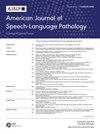脑卒中后失语症远程诊疗筛查新方案初探。
IF 2.3
3区 医学
Q1 AUDIOLOGY & SPEECH-LANGUAGE PATHOLOGY
引用次数: 0
摘要
背景为脑卒中后失语症患者提供远程练习干预与传统的面对面干预相比有效且可行;然而,远程练习评估,尤其是筛查方案,可以促进失语症诊断服务的便捷性,但在失语症文献中得到的研究却很有限。因此,本研究的目的是研究一种针对脑卒中后失语症患者的新型远程实践筛查方案,该方案通过基于表现和患者报告的方法评估语言和语言外认知能力。方法21名曾被诊断为脑卒中后失语症的患者通过远程实践完成了弗伦奇失语症筛查测试(FAST)、失语症影响问卷-21(AIQ-21)、牛津认知筛查(OCS)和获得性脑损伤认知-交流检查表(CCCABI)。参与者的护理伙伴填写了沟通效率指数 (CETI)。远程练习结束后,每位参与者都填写了一份可行性问卷,对其总体体验进行评分。皮尔逊相关分析表明,OCS 和 FAST 分数之间存在很强的正相关关系(r = .74),OCS 和 CCCABI 分数之间存在很强的相关关系(r = -.71),FAST 和 AIQ-21 分数之间存在中等程度的相关关系(r = -.35)。基于绩效的测量与 CETI 之间的关系适中(r = .30)。每位参与者都对远程实践管理的整体可行性给予了积极评价。总体而言,远程实践筛查方案是一种有效且可行的识别卒中后失语症的方法。与面对面的筛查方法类似,识别较轻程度的失语症较为困难。未来的研究应探讨这种远程筛查方案能否在更广泛的卒中人群中识别卒中后失语症。本文章由计算机程序翻译,如有差异,请以英文原文为准。
A Preliminary Examination of a Novel Telepractice Screening Protocol for Poststroke Aphasia.
BACKGROUND
The delivery of telepractice interventions for people with poststroke aphasia has been found effective and feasible compared to traditional, in-person interventions; however, telepractice assessments, particularly screening protocols, which may foster convenient access to aphasia diagnostic services, have received limited examination within the aphasia literature. Therefore, the purpose of this study was to examine a novel telepractice screening protocol for people with poststroke aphasia that assesses both language and extralinguistic cognitive abilities via both performance-based and patient-reported measures.
METHOD
Twenty-one participants with previously diagnosed poststroke aphasia completed the telepractice administration of the Frenchay Aphasia Screening Test (FAST), the Aphasia Impact Questionnaire-21 (AIQ-21), the Oxford Cognitive Screen (OCS), and the Cognitive-Communication Checklist for Acquired Brain Injury (CCCABI). Care partners of the participants completed the Communicative Effectiveness Index (CETI). After the telepractice session, each participant completed a feasibility questionnaire to rate their overall experience.
RESULTS
All participants screened as having aphasia. Pearson correlation analyses yielded a strong positive relationship between OCS and FAST scores (r = .74), a strong relationship between OCS and CCCABI scores (r = -.71), and a moderate relationship between FAST and AIQ-21 scores (r = -.35). Moderate relationships were noted between the performance-based measures and the CETI (r = .30). The overall feasibility of telepractice administration was rated positively by each participant. No significant relationships were found between the feasibility responses and participant characteristics.
CONCLUSIONS
Overall, the telepractice screening protocol yielded an effective and feasible way to identify poststroke aphasia. Similar to in-person administration of screening measures, it was more difficult to identify milder levels of aphasia severity. Future research should examine whether this telescreening protocol can identify poststroke aphasia within the broader stroke population.
求助全文
通过发布文献求助,成功后即可免费获取论文全文。
去求助
来源期刊

American Journal of Speech-Language Pathology
AUDIOLOGY & SPEECH-LANGUAGE PATHOLOGY-REHABILITATION
CiteScore
4.30
自引率
11.50%
发文量
353
审稿时长
>12 weeks
期刊介绍:
Mission: AJSLP publishes peer-reviewed research and other scholarly articles on all aspects of clinical practice in speech-language pathology. The journal is an international outlet for clinical research pertaining to screening, detection, diagnosis, management, and outcomes of communication and swallowing disorders across the lifespan as well as the etiologies and characteristics of these disorders. Because of its clinical orientation, the journal disseminates research findings applicable to diverse aspects of clinical practice in speech-language pathology. AJSLP seeks to advance evidence-based practice by disseminating the results of new studies as well as providing a forum for critical reviews and meta-analyses of previously published work.
Scope: The broad field of speech-language pathology, including aphasia; apraxia of speech and childhood apraxia of speech; aural rehabilitation; augmentative and alternative communication; cognitive impairment; craniofacial disorders; dysarthria; fluency disorders; language disorders in children; speech sound disorders; swallowing, dysphagia, and feeding disorders; and voice disorders.
 求助内容:
求助内容: 应助结果提醒方式:
应助结果提醒方式:


